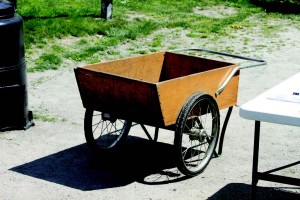↓ Download the Full Newsletter (PDF)
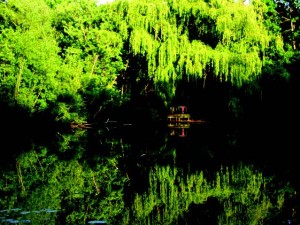
Letter from the Co-Presidents, Ellen Forrester and Betsy Shure Gross
Stewardship, Volunteerism, and the Gift of Time
Ever Since the dedication of Hall’s Pond Sanctuary on June 15, 1975 the citizens of Brookline (Boston, and beyond) have given their Gift of Time to establish and to sustain a conservation ethic and enhanced stewardship through volunteerism at the sanctuary.
While the government traditionally has been solely responsible for public lands and open spaces, over the past four decades private organizations, Friends groups, conservancies, and other entities have partnered with government at the local, state and national level for the benefit of public lands.
The Friends of Hall’s Pond is the first public private partnership 501c3 organization established in the Town of Brookline. For nearly forty years, the Friends have raised funds, published a newsletter, provided thousands of hours of volunteer maintenance, participated in the development of plans for sanctuary restoration and management, and created community work days and educational programming.
Stewardship at Hall’s Pond Sanctuary is a shared responsibility. From the 1975 acquisition of the site, the Friends have been involved in the development of public policy and decision making for Hall’s Pond through our partnership with the Brookline Conservation Commission.
The most recent example of this public private partnership collaboration is the creation of The Eris Doorneweerd Entry from Amory Park into Hall’s Pond. Erin Gallentine, Director of the Town of Brookline Division of Parks and Open Space along with her staff, friends of Eris, and the Friends of Hall’s Pond Co-Presidents created this enhancement of the Sanctuary entrance in tribute to Eris and to the shared vision which results from a flexible partnership relationship built over time to benefit public open space.
We encourage all of our readers to become more involved in the life of Hall’s Pond Sanctuary.
Like our fabulous Board of Directors and the Maintenance Team which devotes their time to augmenting the work done by the Town, we hope that many of you will join us in visiting the sanctuary, participating in Community Work Day activities, and making a financial contribution to support our purchase of planting materials and the publication of our newsletter. We are an all VOLUNTEER group sharing our skills, love of the environment, interest in urban ecology and horticulture and the protection of urban wildlife in a public space and we welcome new members to our work. Join us!

Volunteer Maintenance Team
by Frank Caro, Maintenance Volunteer Coordinator
The volunteers who maintain Hall’s Pond throughout the growing season have enjoyed another productive year. Through their twice-monthly work sessions, our volunteers groom the formal garden and contain the growth of invasive vegetation in the Sanctuary. Over the years, the formal garden and the Sanctuary have benefited from the efforts of volunteers who came regularly to supplement the accomplishments at the Community work sessions. The volunteer maintenance work is more formally organized now than it was in the past. Currently, all of the volunteer work being accomplished is done on a group basis with a plan for each session that is approved by the staff of the Conservation Commission.
Following a pattern that is well established now, we began the year with a focus on the formal garden. This year, we were able to do more than control weeds and deadhead the perennials. We revitalized a section with the planting of some new roses. We planted several Clematis vines on the arch at the entry to the garden. In the past, several flowering vines competed with one another on the entrance arch. None excelled. Clematis holds great promise as a well-behaved vine that produces abundant attractive flowers. We also expanded the area available for the garden by removing some self-seeded shrubs on the perimeter of the garden. With the flower beds more visible, we hope to revitalize the plantings in the perimeter beds in the coming years. In “Nan’s Meadow,” we expanded the sedge planting near the entrance. Sedge is a grass-like plant that completes effectively with weeds and grows successfully while requiring little maintenance.
In the Sanctuary, we continue to give special attention to clearings where we have planted trees and shrubs recently. Because they allow abundant sun light, these areas are particularly attractive to invasive vines that include bittersweet, wild grape, and porcelain-berry. If we are not attentive, the vines grow quickly to cover the shrubs and young trees and we would lose the shrubs and trees that we are encouraging.

We are working also in some of the more hidden areas in the Sanctuary that have received little attention for many years. In these areas, well established invasive vines have grown along the ground until they found understory shrubs through which they launched climbs that have taken them far up into the trees. We have found disfigured trees that were covered almost entirely by massive vines. We start by looking for vines in the tree tops. After doing our best to pull the vines from the trees, we hunt through dense understory vegetation to find the places where the vines began their ascent. To the extent that we can, we remove the roots. In the past few years, we have made substantial progress in clearing out these well-established vines.
We rely heavily on a few volunteers who are active from spring through fall. This year Priscilla Smith, Janet Wynn, Bruce Wolff, Harry Breger, and Anne-Marie Kamin were our most active volunteers. Others who made valuable contributions included John Harris, Neil Gore, Helen Herman, Alex Krieger, and newcomers Deanna Springfield and Scott Anderson.
We have a continuing need to expand our group of volunteers. We particularly need a few volunteers who are available during the summer travel season.
Next year, I hope to offer maintenance sessions in the formal garden on weekends. Some members want to volunteer but are available only on weekends. Our current volunteers prefer to work on weekday mornings. When we have a few more members who want to volunteer on weekends, we will have more reason to organize weekend sessions.
If you may be able to help out at any time during the next spring, summer, or fall, please contact Frank at: frank.g.caro@gmail.com, or call him at 617-739-9228.
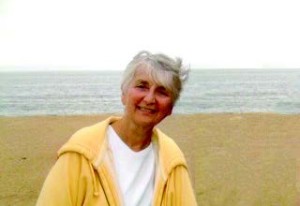 Celebrating The Life of Eris Doorneweerd:
Celebrating The Life of Eris Doorneweerd:
Teacher, Mentor, Friend of Hall’s Pond
by Betsy Shure Gross, Co-President
“Eris Doorneweerd was the kind of teacher every parent dreams of. She had a genius for teaching traditional subjects in innovative ways … teaching science in the natural world, making Hall’s Pond Sanctuary an extension of her classroom,” recalled Driscoll School Principal Carol Schraft in her Words of Remembrance at the school’s Memorial Service for Eris.

From 1977–2006, Eris taught at the Driscoll School in Brookline. Here she developed teaching practices that became hallmarks in the education of young children.
Among these hallmark practices was Eris’s creation of The Hall’s Pond Learning Project with her 1st and 2nd graders in Room #204 who learned to love the sanctuary as a four season outdoor classroom.
Principal Schraft continued, “Most of what I know about how to teach young children I learned from Eris. I do not mean teaching children to read or compute math—Eris certainly did those things—but I learned what it is to reach deep inside a child and capture the spark that will make him or her a learner for life… Eris never confined her class to the walls of Driscoll School—she was a frequent field tripper. Her most frequent destination was Hall’s Pond and that is where she will be remembered.”
And, indeed, Eris will be remembered at Hall’s Pond. Upon her retirement from teaching, The Friends of Hall’s Pond planted a tree in her honor in appreciation for her gift of time, passionate commitment to the education of children about the natural world, and her belief in the power of nature in the urban environment.
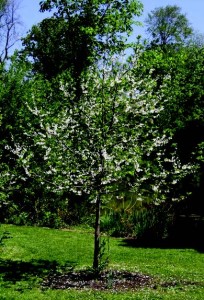
And, late this Spring when Eris knew she was dying, her friend, Wallis Wickham Reamer, talked to her about how she wanted to be remembered. The Friends of Hall’s Pond are touched, and grateful, that in recognition of Eris’s love of, and continuing commitment to, this unique urban resource and outdoor classroom, Wallis was inspired to create a fund raising campaign which raised over $12,000 for a Memorial Planting in Amory Park at the entrance to the Hall’s Pond Sanctuary. Partnering with the Town of Brookline Parks and Open Space Division, Wallis and the Friends have agreed upon a design and the Eris Doorneweerd Entry will be dedicated on the afternoon of May 18, 2014. The Entry plantings plus a new bench will enhance both Amory Park and Hall’s Pond Sanctuary and will be a living testimony to a splendid teacher and an unforgettable Friend of Hall’s Pond.
Redesigned Sanctuary Entrance
By Annie Blair, Landscape Architect, Parks and Open Space Division, Town of Brookline
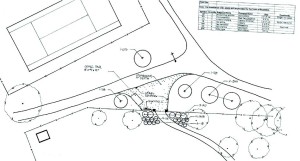 The intent of the redesign of the southern Halls Pond Sanctuary entrance was to provide a welcoming experience and an attractive setting for Eris Doorneweed’s memorial bench. We took some clues from the northern sanctuary entrance, and incorporated more seasonal interest and variety in the planting selection. We used all native plants, and took the opportunity to include two native Salix nigra (Black Willow). We also wanted to create a sense of enclosure with tree canopy, and reduce the scale of the sign board by eliminating the bulletin board that formerly accompanied it and placing it lower to the ground. The sign was relocated to accompany the new bench, and the back of the board is screened with a mix of deciduous and evergreen shrubs inside the sanctuary on both sides of the gate.
The intent of the redesign of the southern Halls Pond Sanctuary entrance was to provide a welcoming experience and an attractive setting for Eris Doorneweed’s memorial bench. We took some clues from the northern sanctuary entrance, and incorporated more seasonal interest and variety in the planting selection. We used all native plants, and took the opportunity to include two native Salix nigra (Black Willow). We also wanted to create a sense of enclosure with tree canopy, and reduce the scale of the sign board by eliminating the bulletin board that formerly accompanied it and placing it lower to the ground. The sign was relocated to accompany the new bench, and the back of the board is screened with a mix of deciduous and evergreen shrubs inside the sanctuary on both sides of the gate.
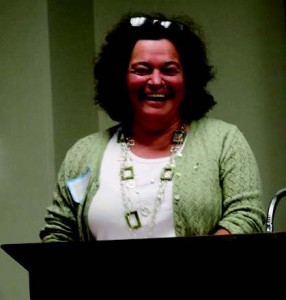 A Horticultural Maven at Hall’s Pond Sanctuary
A Horticultural Maven at Hall’s Pond Sanctuary
Every once in a while in the life of an organization comes a board member whose gift of time and level of expertise make working with her a very special experience for everyone.
This issue of the Newsletter is dedicated to Ellen Forrester, our Co-President for Horticulture.
Ellen exemplifies stewardship and volunteerism at its very best. Her willingness to share her understanding of the principles of stewardship of both the conservation areas in a wildlife sanctuary and of the very different challenges of the formal garden’s care, her superb collaboration with the Brookline Conservation Commission’s Conservation Agent and Tree Warden Tom Brady, her work on the creation of The Sanctuary Management Plan, and her expertise in selecting and acquiring appropriate plant materials are invaluable contributions to our volunteer endeavors.
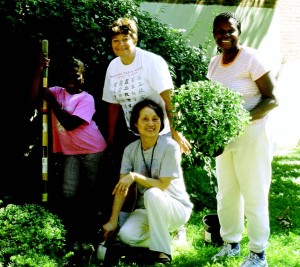
Ellen is a graduate of the Landscape Institute of Harvard. After completing design school, she continued her horticultural studies by successfully completing the U/MASS Extensions Green School to be certified as a Mass. Certified Landscape Professional (MCLP) and she achieved certification as an Organic Land Care Professional (AOLCP) through the Northeast Organic Farming Association (NOFA ).
Thank you, Ellen, for your sense of humor, for your dedication and for your passion, your incredible energy, and for your extraordinary commitment to the health and safety of Hall’s Pond Sanctuary.
 Behind the Scenes
Behind the Scenes
by Tom Brady, Town of Brookline Conservation Administrator and Tree Warden/Town Arborist
As we look to the Winter season we pause in the Conservation Office and reflect on the past year to learn from the experiences of this year and to see how we can improve the health of the flora and fauna in the Sanctuary and how we may be able to improve upon the experience for visitors in the coming year.
This past year was one of gentle changes in the sanctuary. Many changes took place that will impact the Sanctuary. Some of these were striking changes one is sure to note, some were a bit more subtle, and some may be completely out of sight but have a very real impact on the sanctuary.
Ongoing horticulture activities by Town staff this past year included work in and around the formal garden as well as work on the trees, shrubs, herbaceous plants, and wetland systems that can be found throughout the Sanctuary. These activities included planting, pruning, management of invasive plants, and where appropriate, removal of plant materials. Small repairs and improvements continue to be implemented throughout the Sanctuary to ensure that the user has an enjoyable experience. We are pleased the vast majority of these repairs and improvements were implemented with no impact on the visitors.
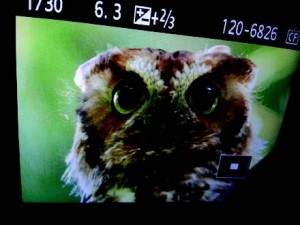
Some of the properties which surround the Sanctuary underwent some change this year and, in a few cases, this has altered the experience of the visitor. Working with the Friends, we will be implementing new plantings of appropriate vegetation in the affected areas.
And, finally, in the case of sight unseen improvements, the Engineering Division has completed work in the Beacon Street Corridor which will improve the water quality which discharges to Hall’s Pond. This work will help ensure that the Pond remains in good health for many years.
We hope you have an enjoyable Winter season and we’ll look forward to seeing you in the Sanctuary.

In and Around the Garden
by Ellen Forrester, Co-President Halesia tetraptera (Silverbell)
Everyone should have this perfect urban tree. And since I cannot put one in each garden around town, it was chosen because it would be a wonderful addition to Hall’s Pond Sanctuary. This wonderful tree was funded by donations way back in 2006 to honor the retirement of Eris Doornweerd. She had always been an important figure in the work of The Friends of Hall’s Pond and in the life of Hall’s Pond Sanctuary. Small but mighty sums it up. Halesia works well in a woodland edge or as a specimen tree. The May flowers are a marvelous white bell shape, clustered along the branches. They develop into an intriguing long, four winged fruit. You need to get close to notice the proliferation, but once you know, you will be hooked. The tree at Hall’s Pond is a single stemmed small tree with a nicely shaped crown. It turns a glorious golden color early in the fall and then the smooth grey bark is apparent during the winter. Since everyone loves this little tree, we decided to add another to the new Eris Doorweerd Entry to Hall’s Pond. Come, take a peek, enjoy!
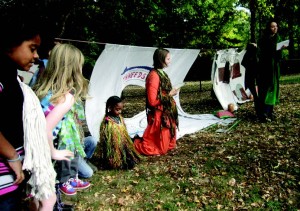
Dr. Seuss’ Lorax Comes Alive
by Brandon Schmitt, Park Ranger, Division of Parks and Open Space, Town of Brookline
On October 19th, families gathered at Amory Park for the second annual Lorax project. Organized through the Recreation Department by the town’s Environmental Educator Stephanie Springer, the project offered a unique educational opportunity for children and their families to watch a live enactment of the Dr. Seuss’ classic, and put the Lorax’s message of sustainability and cultivation of new life into practice at Hall’s Pond Sanctuary. Along with Stephanie, recreation staff Alayna Cruz and Rachel Carbonara, and Park Ranger Brandon Schmitt donned costumes of the Lorax, Swomee-Swans, Barbaloots, and Humming fish characters and acted out the story to a captive audience. Many of the children in attendance were also part of the act, playing the beloved Truffula Trees.
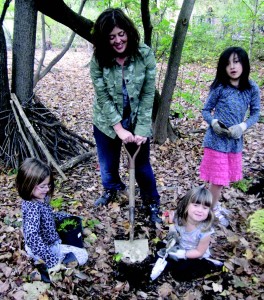
With the sanctuary providing the perfect backdrop, the audience and cast members depicted the cautionary tale of indifference towards nature and ecological imbalance. The final words of the Lorax implore the reader to “Plant a new Truffula. Treat it with care. Give it clean water. And feed it fresh air. Grow a forest. Protect it from axes that hack. Then the Lorax and all of his friends may come back.” And so the participants did just that, planting 24 new native ferns in the sanctuary near the western overlook area. It was a great opportunity for the participants to learn about the plant community that lives in the sanctuary, and how to plant a fern while getting their hands dirty together as a family. Following the fern planting, the families re-grouped at the Amory picnic tables to pot their own “Truffula seeds” to take home with them.
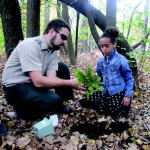
Dr. Seuss wrote that “unless someone like you cares a whole awful lot, nothing is going to get better.” In addition to providing a superb setting for outdoor theater, Halls pond exemplifies a place about which people care an awful lot, and consequently make this place better for all of us. The Lorax Project is an important day at the sanctuary because it brings families together outside in a fun and educational atmosphere offering a truly unique way to learn, to interact with, and to build appreciation for Hall’s Pond.
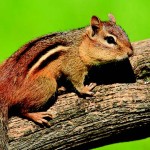
Country Meets the City
By Fred Bouchard
The trees are in their autumn beauty The woodland paths are dry Under the October twilight the water Mirrors a still sky Upon the brimming water among the stones Are nine and fifty swans… But now they drift on the still water Mysterious, beautiful. Among what rushes will they build, By what lake’s edge or pool Delight men’s eyes, when I awake some day To find they have flown away? —W. B. Yeats, The Wild Swans at Coole

On a sweet and hazy last day of summer, it was hard to think ahead to fall and winter. As we walked the paths of Great Meadows Sanctuary in Concord, I thought how ephemeral these moments are when the seasons come to an end. Yet also how alike the critters were at Hall’s Pond, our little rus-in-urbe, smaller to be sure, yet not unlike Yeats’ haunting spot by Lough Coole in Fermanagh, Ireland.
White-legged grasshoppers strode ahead on the path, or skittered to the sides. Dragonflies split the air; mating red meadow-hawks buzzed my ear. Butterflies came along: a lone viceroy, a few orange sulphurs, several cabbage whites – yet, this year, ominously, nary a monarch.
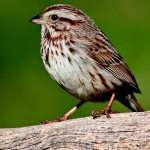
I started briefly to see a black silver-dollar-sized snapping turtle—fresh from the egg, dazed and logy—lie athwart our path. I gently lifted her up and placed her by the reeds, a move that disturbed a yellow-lined garter snake and caused it to angle smoothly away through the grass.
An occasional chipmunk chittered by his tree-roots den-entry, and squirrels whined in the upper branches. A great blue heron squawked along the dike and into the water chestnuts, and a few late tree swallows aerialed beneath the clouds. Streaked song sparrows and a brighter swamp sparrow flitted ahead of us; then a common yellowthroat peeked through the reeds with a brief witchy-witchy.
In the woods, the ‘usual suspects’ made their presence known: deedling chickadees, inquisitive titmice, twittering goldfinches, nagging nuthatches. Canada geese flocked stridently overhead, mute swans and their large gray cygnet plumbed the water-lily ocean for shoots, and a few female mallards ‘aflac’-ked by the water’s edge.
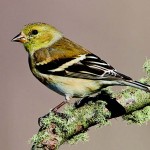
Then it struck me that, of all the fauna noted during an hour’s walk through rural Concord, only a few creatures would seem out of their element at urban Hall’s Pond. These were a brilliant green, black and yellow-striped Northern Leopard Frog, a chittering Marsh Wren flicking through the cattails, and a Virginia Rail heard yakking near the parking lot. (And those swans, of course—looking fine at Yeats’ Coole Lake and in Concord’s swampy precincts—would find themselves mightily cramped in our little cedar swamplet! But you get the idea.)
The pathside flora, too, would have many identical individuals in Brookline—tiny white asters, gleaming goldenrod, yellow-gemmed jewelweed, pink multiflora rose and chrysanthemums. It’s notable, though, that through our assiduous and deliberate program of planting native species and uprooting invasives at Hall’s Pond, we can add a wider range of species to the local list.
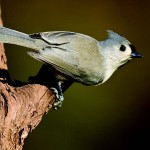
We city-dwellers are filled with gratitude that some rural denizens still readily inhabit a few cherished corners of Boston, that we have our little getaway spots to enjoy what Roman poet Ovid famously called our rus-in-urbe, our blessed patch of country-in-the-city.
With a longer-than-ever glorious fall behind us and cold, short days a-coming, it behooves us to bustle ourselves, get out, stretch legs and spirits in the nippy mornings, meet our neighbors, and greet the sun and overwintering birds and mammals with cheer.
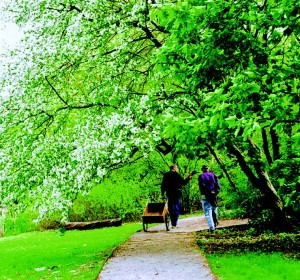
An Old Mainstay of Sanctuary Cleanups Keeps On Rolling
by Ferris Hall (but of no known relation to Minna Hall)
This wagon/wheelbarrow was given to me by father-in-law in the Autumn of 1971. It was a housewarming present for the new home that Nancy and I had just purchased at 14 Amory Street. Mr. Klauder made the wagon from a kit in his basement in Moorestown, NJ and drove it to Brookline—with the wheels disassembled.
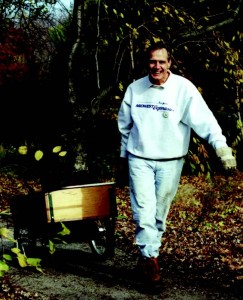
Starting with the first Hall’s Pond cleanup in November 1975 the wagon has been in attendance for every cleanup, Fall and Spring, except for two sessions when its owner was out of town. I recall the first few workdays when it was used helping to remove unusual items from the Sanctuary including a small refrigerator, sink and bicycle, most of which were discovered in the Pond itself. I suspect there are other similar undiscovered items because this cedar pond is said to be relatively bottomless. The wagon also delivered the dozens of white pine trees scattered throughout the uplands; not such a big undertaking, because at that time they were each about six inches tall! The past several decades the wagon has been used to remove dead branches in the Spring and leaves in the Fall but, prior to that, these items were all simply carried or raked into the wetlands adjacent to the pond—which we subsequent have learned, was an ecological no-no. The wagon and its owners are looking forward to 2015,
Hall’s Pond B-SPACE Committee Letter
TO : Betsy DeWitt and Alan Morse,
Co-Chairs B-Space Committee From: Betsy Shure Gross and Ellen Forrester,
Co-President, Friends of Hall’s Pond
Date: June 20, 2013
Re: B-SPACE Committee Selection Process plan for building a new school in Amery Park
As many of you know, Hall’s Pond is a wildlife sanctuary owned by the Town, managed by the Conservation Commission and supported since 1976 by a 501c3 private non-profit corporation, The Friends of Hall’s Pond. We support the Conservation Commission by regular sanctuary management volunteer maintenance team initiatives, by raising funds for horticultural plantings, by providing educational programs, tours and Spring and Fall Community Day activities, and by publishing a newsletter for the community. Most recently we have participated in a fundraising initiative to create a new entry area for the sanctuary in memory of a beloved former board member and creator of The Hall’s Pond Learning Project.
Hall’s Pond is a unique urban resource which supports a diverse population of plants and animals on five acres of conservation land adjacent to Amory Park in the Cottage Farm Local Historic District and is listed on the State and National Registers of Historic Places. Because North Brookline is both densely developed and lacks adequate open space, Hall’s Pond provides a resource for studying and quiet enjoyment of nature. Protected under the Massachusetts and Brookline Wetland Protection Acts, the sanctuary is home to great blue herons, black-crowned night herons, kingfishers, red-winged blackbirds, and owls, among others, and is a critical highway for migration as it offers birds the attractions of marsh, thicket, upland, orchard and wood. Other wildlife such as turtles, fish, and water fowl are plentiful at the pond.
Not long ago, over one million dollars of local, state and federal funds were invested at Hall’s Pond, restoring conditions around the pond, unifying Amory Woods and Hall’s Pond into a single nature sanctuary, enhancing the ecological integrity of the sanctuary, improving water quality, and restoring wetland functions.
We ask the B-SPACE committee to note our grave concern about any detrimental impact on this fragile ecological urban resource.
Thanks to the new Friends of Amory Park and the Pct. 1 Town Meeting Members for their defense of Amory Park and Hall’s Pond.

